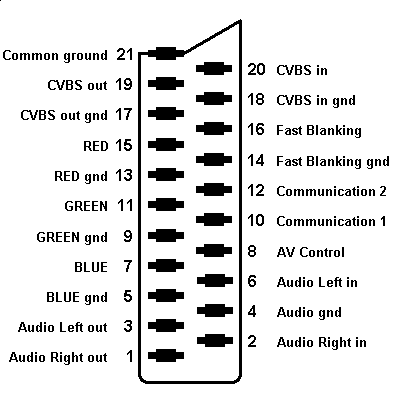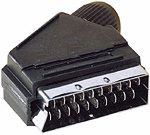SCART Euro connector
We, in Europe, have been long been blessed with the standard SCART connector to connect all kinds of video equipment to the TV set.
For the end user it's handy to have all connections in one plug, but I must admit that the design of the SCART connector is far from being perfect.
The construction is too weak for the heavy cable that usually comes out of it.
It's not seldom that sound or picture is disrupted because the connector is almost falling out of the socket.
Fortunately its days are numbered now video connections are mainly digital nowadays.
There is a lot of rubbish available on the market.
If you are going to buy a Scart cable, see to it that it's a fully shielded version.
I often got the complaint that a ghost picture can be seen behind the picture that is played back from a VCR or Set top Box.
The reason for this is the cheap, unshielded cable that was used.
SCART connectors transport the signal in two ways.
From VCR or Set top Box to the TV and from the TV tuner back to the VCR or Set top Box.
These two signals run close to one another over a length of 1.5m or more and cross talk is unavoidable without proper shielding.

This picture shows the pin assignments as seen when looking into the chassis connector.
Signal Description
RGB is on if 1 to 3V
AV mode with 16:9 aspect ratio if 5 to 8V
AV mode with 4:3 aspect ratio if 9.5 to 12V
Note that audio and CVBS signals are bi-directional for there are wires available for both directions.
RGB is only possible in one direction.
CVBS stands for Chroma, Video, Blanking and Sync, all components combined in a composite video signal.
With S-VHS the Chroma signal is transferred over a separate wire.
In that case the CVBS pin will not carry the Chroma part of the signal.
S-VHS is only possible in one direction, for only one RGB wire is sacrificed for this purpose (RED).
RGB mode is not possible when in S-VHS mode.
This is usually no problem because VCRs rarely ever produce RGB signals.
The communications lines are used by many different standards for remote control purposes.
Some transfer I²C signals over these wires while others send the electrical equivalent of IR commands.
Philips has tried to create a new standard for these wires under the name AV-Link.
Some SCART cables may not support all functions. E.g. the RGB signals are not always supported. Those cables are cheaper than the fully equipped cables and are adequate for most applications. But see to it that all signal lines are fully shielded to avoid cross talk!
 We, in Europe, have been long been blessed with the standard SCART connector to connect all kinds of video equipment to the TV set.
For the end user it's handy to have all connections in one plug, but I must admit that the design of the SCART connector is far from being perfect.
The construction is too weak for the heavy cable that usually comes out of it.
It's not seldom that sound or picture is disrupted because the connector is almost falling out of the socket.
We, in Europe, have been long been blessed with the standard SCART connector to connect all kinds of video equipment to the TV set.
For the end user it's handy to have all connections in one plug, but I must admit that the design of the SCART connector is far from being perfect.
The construction is too weak for the heavy cable that usually comes out of it.
It's not seldom that sound or picture is disrupted because the connector is almost falling out of the socket.
